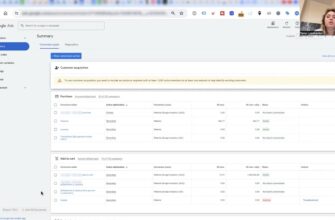- Why create a budget forecast in Google Ads?
- What is important to consider when forecasting costs in contextual advertising?
- How to calculate your budget in Google AdWords: 4 ways
- We prepare a Google Ads budget forecast based on expenses.
- We calculate the budget for contextual advertising based on keywords.
- We calculate the advertising campaign budget based on the conversion price.
- ROI calculation method
- What data should be used as a reference when analyzing the budget?
- Common mistakes when planning a budget for contextual advertising
- Do not take marginality into account
- Distribute the budget evenly among all requests
- Do not use advanced tools
Forecasting a Google AdWords budget is one of the most difficult tasks faced by both new and experienced internet marketers. Budget planning can seem quite complicated and time-consuming for those who have not dealt with it before.
A well-written Google AdWords budget forecast is a guarantee of the success and effectiveness of an advertising campaign.
Why create a budget forecast in Google Ads?
Budget forecasting in Google Ads allows you to easily:
How many calls and sales will I get by ordering contextual advertising from you?
I need to calculate the conversion of my website Describe
the task
in the application
Calculate potential ad revenue Google
contextual advertising calculator
- Determine the optimal position for your ads. You can find out how much money you need to invest to achieve the desired positions in search results. This allows you to avoid overpaying for special placement or, conversely, losing audience reach due to insufficient investment.
- Calculate the cost per click. When making a forecast, you can compare the cost per click and the expected traffic when using broad or exact match keywords. Knowing your target budget and desired positions, you can predict the number of clicks and the cost per click, which helps you estimate the potential return on investment from your advertising campaign.
- Assess the potential in a new niche for yourself. You will be able to understand advertising pricing in a previously unfamiliar subject area without spending any real money. If the forecast shows a minimum number of clicks even at high costs, this indicates that this area has low potential. Budget forecasting will help you identify low-competition or irrelevant queries and optimize your campaign before it even launches.
What is important to consider when forecasting costs in contextual advertising?
When preparing a budget forecast for contextual advertising in Google AdWords, it is important to understand the following:
- The final figures are a forecast and may not match actual performance due to factors such as varying ad clickability, competition levels in the niche, and the quality of the ad and landing page.
- During the course of a campaign, advertisers often change their budget to adapt to changes in external conditions.
- An advertising budget is primarily an investment in the future development of a campaign, not an expense. You need to be prepared for the fact that some investments may take a long time to pay off—from several months to a year.
How to calculate your budget in Google AdWords: 4 ways

This is a reasonable question that newcomers to PPC constantly ask: “How do I calculate my Google Ads budget?” Newcomers to PPC are most interested in what results they will get from advertising on Google and how much money they need to allocate to it.
There are three main methods commonly used to calculate the budget for an advertising campaign:
- Budget from expenses;
- From keywords;
- From the acceptable conversion cost.
It is certainly possible to determine your budget based on costs or keywords, but neither of these methods takes into account the objectives of a real business, which may include generating revenue from an advertising campaign, increasing the number of applications, or expanding the customer base (reach).
Let’s take a closer look at each of these methods, their pros and cons.
We prepare a Google Ads budget forecast based on expenses.
Almost all novice advertisers plan their budget based on their planned campaign costs. We recommend allocating a minimum amount of at least $100 for testing.
Important! For new accounts, Google offers welcome bonuses when you top up your advertising account with $100 or more. This bonus can be up to $75 in addition to the top-up amount.
The resulting amount of $175 will be enough to attract 300-400 visitors, which will allow you to get your first targeted leads and, in some areas, your first advertising revenue. After that, the results are analyzed, and you can gradually increase the budget and be sure to optimize the campaign settings, since simple scaling without optimization can lead to the ad working at a loss.
We calculate the budget for contextual advertising based on keywords.
This method of budget forecasting is commonly used by online agencies. As a rule, this method is not the most accurate, but it can give advertisers an idea of the approximate average cost per click for a specific topic, the volume of traffic and competition in the niche, and also allows them to estimate future advertising costs.
To analyze using this method, it is best to use Google’s Keyword Planner tool. This is an incredibly useful and powerful keyword research tool built into the AdWords interface that helps users find new keywords based on existing niche-specific queries.

A valid AdWords account is required to use the Keyword Planner. The Keyword Planner can be found in the Tools and Analysis section.
To collect semantics using this tool, select up to 10 main queries that users search for your business, enter them into the “Planner” and click on the “Start” button. The application will show the most popular queries in the subject area.

In the “View number of requests and forecasts” tab, you can find keyword frequency, clickability, click forecast, and estimated cost per click.
To calculate your budget, compile a list of key phrases, go to Keyword Planner, and find Budget Planning and Forecasting in the tools section. There, you can enter your figures (keywords, planned expenditure, per day, and region of ad display) and get an estimate of traffic to your site based on the parameters you specify.
The tool is really well designed, easy to use, and includes everything you need to forecast your Google AdWords advertising budget.
How many calls and sales will I get by ordering contextual advertising from you?
I need to calculate the conversion of my website Describe
the task
in the application
Calculate potential ad revenue Google
contextual advertising calculator
We calculate the advertising campaign budget based on the conversion price.
The most effective way to calculate a campaign budget is to focus on an acceptable cost per acquisition (CPA) for the business. This method is designed to get the most out of advertising and takes internal business processes into account.
How do you determine an acceptable conversion price? Usually, it is no more than (the less, the better) 50-70 percent of the margin that the business receives from a single sale. Next, you need to calculate how many orders the advertiser is ready to process during the period and multiply this number by the acceptable CPA.
Example. A tailor shop sews wedding dresses with a margin of $200. The maximum price per conversion is $100. Tailors can sew up to 10 dresses per month. This means that the advertising budget should be $1,000 per month.
By analyzing the budget, a PPC specialist can set up advertising campaigns that will pay for themselves and generate profit.
Important! Many customers like to underestimate their margins. This approach is incorrect, as it can result in inaccurate data and an incorrect assessment of the tool’s effectiveness without testing it. Also, do not forget about the LTV of each customer. For example, a customer who orders a wedding dress may order other items from the same atelier in the future if she likes the quality of the work, or she may recommend it to her friends.
ROI calculation method
This method allows you to evaluate the effectiveness of investments and predict the expected return on investment in marketing. The Return on Investment indicator itself shows how much profit each hryvnia invested in advertising brings.
With this approach, the budget is based on the income or net profit you want to get from the advertising campaign. Before calculating, it is important to determine the desired level of return on investment, for example, 200%. Then, the amount of investment required to achieve this result is calculated.
The following formula is typically used to calculate ROI:
ROI = (Net profit / Advertising investment) x 100%
Net profit here is the difference between sales revenue and advertising costs, and marketing investment is the amount spent on displaying ads.
What data should be used as a reference when analyzing the budget?
After forecasting your monthly budget for Google Ads and knowing the average click-through rate of your ads and website conversion rate, you can try to calculate your ROI (return on investment in advertising). If you have not advertised before, it is best to use average figures as a guide:
- Advertising CTR – 10%;
- Conversion rate for landing pages – 4-6% (depending on the topic);
- Conversion rate for e-commerce – 1-4%;
- Sales manager conversion rate – 60-80%.
The data obtained will give you a rough idea of how many orders you will receive after setting up your ad and whether your investment will pay off. You can get more accurate information by running your ad for a trial period (Google offers a welcome bonus for new accounts for this purpose).
Common mistakes when planning a budget for contextual advertising
Many novice advertisers make similar mistakes when drawing up an advertising budget, which can lead to unsatisfactory results for the entire campaign and a loss of investment.
Do not take marginality into account
When planning their Google Ads budget, business owners often arbitrarily determine their monthly spending without considering the potential profit from the advertising campaign. It would be more reasonable to try to estimate the margin and possible income in advance and then plan advertising investments taking these factors into account.
Let’s say you sell a product for 2,000 hryvnia and want to get a 300% return on your advertising investment. In this case, it makes sense to spend no more than 600 hryvnia to attract each customer. Knowing the average conversion rate of visitors to customers, you can calculate the acceptable cost per click and plan your budget.
To accurately estimate your budget, start by defining the ultimate goals of your Google Ads campaign. If your goal is to get a certain number of orders:
- Based on your sales target and current conversion rate, calculate how many leads (applications) you will need.
- Based on historical conversion data, determine the amount of traffic required to achieve the calculated number of visits.
- Use the average cost per click for your topic and calculate the budget that will ensure you attract the right number of visitors.
If you do not yet have historical data for previous periods, determine the acceptable cost of the application at which the advertising will be profitable. Ideally, it should not exceed the profit from a single sale. This will ensure that your advertising campaign breaks even.
Distribute the budget evenly among all requests
The other extreme is to divide the entire advertising budget equally among all keywords. At first glance, this seems like a logical and fair solution. But upon closer inspection, it turns out that this approach is not very effective.
High-frequency queries usually generate a lot of traffic but have a low conversion rate. Low-frequency queries generate higher-quality leads and attract the target audience. An equal distribution of the budget will result in the lion’s share of expenses going to ineffective queries, with a minimum remaining for transactional keywords. As a result, you will get a lot of clicks and few sales.
How can you allocate your budget between keywords correctly? Focus on the potential revenue that each search query can bring. To do this, you need to estimate the average check and conversion rate. Ideally, you should set individual bids and daily budgets for all important and most marginal key phrases.
Do not use advanced tools
When drawing up their budgets, many advertisers limit themselves to standard tools (for example, they use the Keyword Planner built into Google Ads).
At the same time, it does not take into account seasonal demand, conversion dynamics, and the characteristics of your target audience. As a result, the data obtained may often not match the actual figures.
It is better to pay attention to more advanced tools with extended functionality:
- Contextual advertising calculators. These services allow you to set many more parameters, such as the average cost per click and conversion rate for a specific niche, the cost of attracting a single customer, and so on. The more factors you take into account, the more realistic the calculation will be.
- Services for analyzing seasonal demand. Tools such as Google Trends will help you build a graph showing the popularity of queries in your field based on historical data. You will be able to see which months you will need to spend more on advertising and which ones less. This will help you optimize your annual budget, taking into account fluctuations in demand.
- Tools for assessing the potential of key phrases. They rank search queries by potential revenue and help you allocate your main budget to the most profitable ones. This will allow you to avoid wasting money on ineffective keywords and focus on those that will bring maximum profit.
















